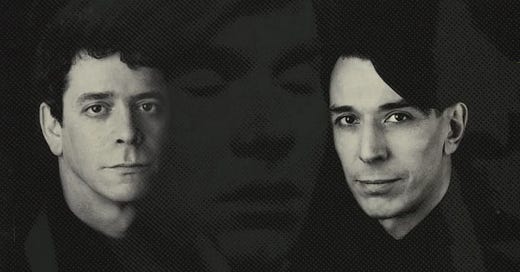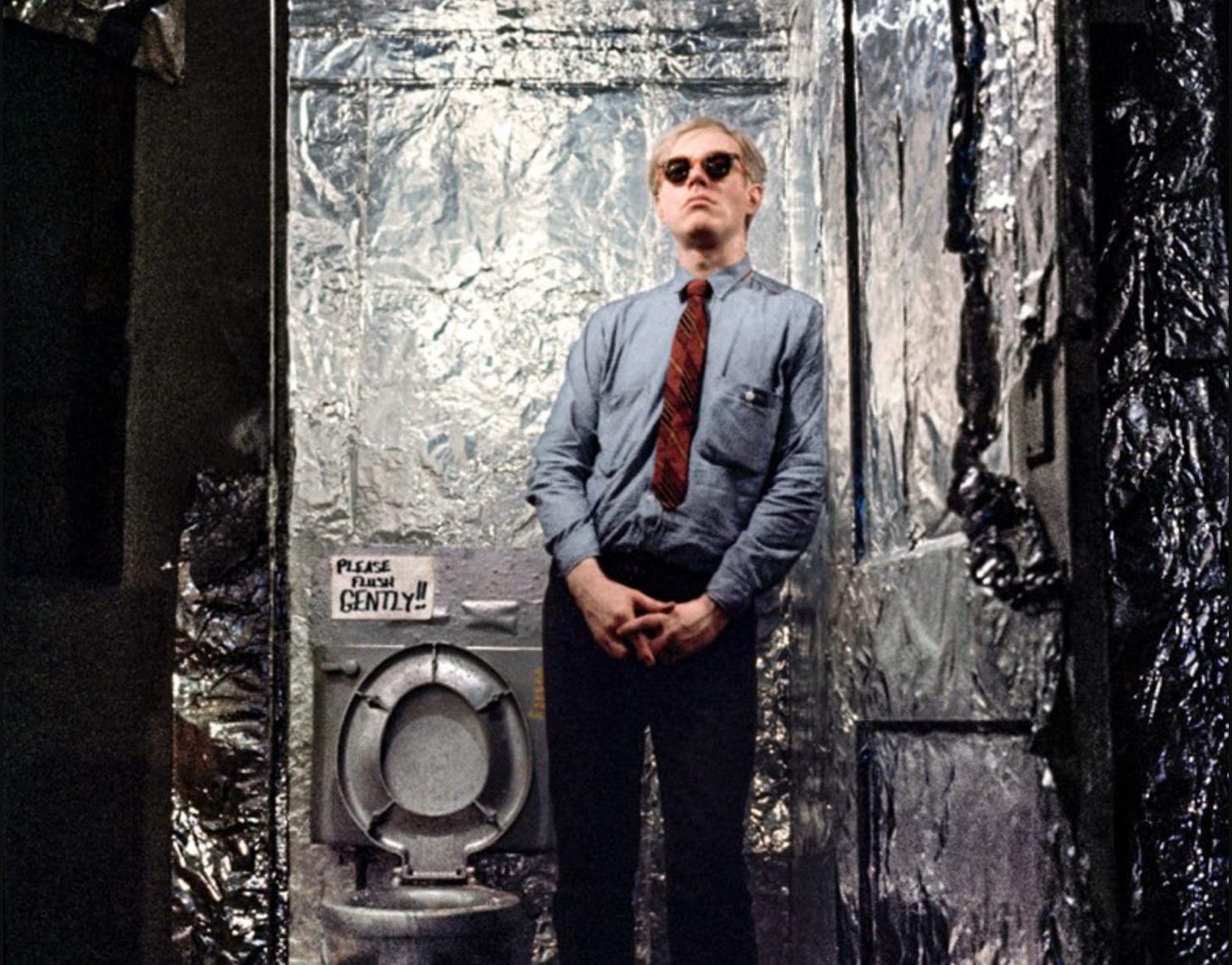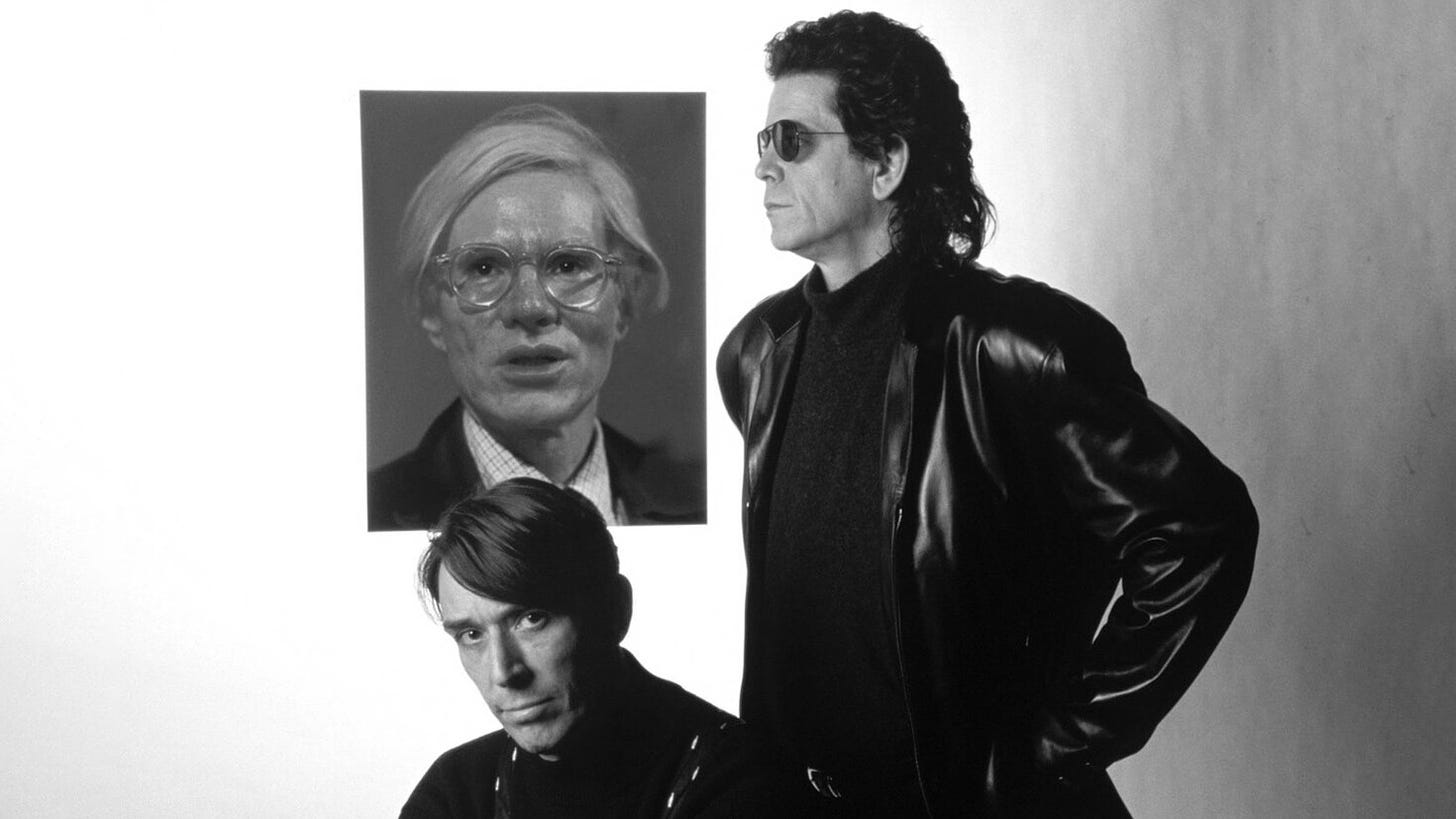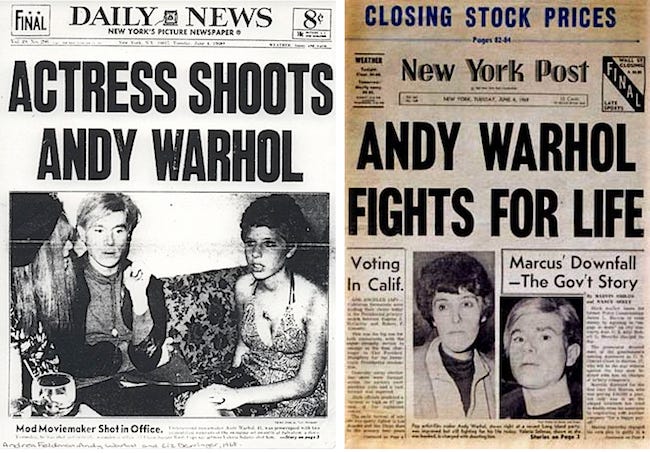LOU REED / JOHN CALE: SONGS FOR DRELLA
ALBUM REVIEW: Ex Velvets pay tribute to friend and mentor Andy Warhol in moving bio, memorial and obituary album from 1990, three years after his death.
Lou Reed / John Cale: Songs for Drella
Sire Records
1990
22 February 1987: New York Presbyterian Hospital, NYC
Andy Warhol, world famous artist, hero, mentor and pop cultural icon died following routine gallbladder surgery. Ventricular fibrillation. He was 58.
Almost twenty years earlier, in 1968, he survived a near fatal assassination attempt, at the Factory, his place of work, when Valerie Solanas, a paranoid writer and actress already known to him, shot him three times in the abdomen. He momentarily died on the table and the effect of the shooting made him paranoid, depressed and even more introverted, for the rest of his life.
Almost twenty years before that, in 1949, a 21 year old Andrew Warhola Jr moved to New York City from Pittsburgh, to follow his career as a commercial illustrator.
His life in New York was spectacular. He became a cultural lynchpin. His base of operations, The Factory, on East 47th Street, became the hub for artists, misfits, musicians, junkies and wannabees from 1963 until it finally closed, following his death, in 1987.
He painted, printed, made films, curated happenings and invented punk with The Velvet Underground. He mixed with celebrities from Mick Jagger to Elizabeth Taylor. Anyone who was anyone hung out at the factory. Especially in the 60s and 70s.
Andy was the Queen of New York.
Lou Reed and John Cale
A huge part of his legend hinges around his involvement with Lou Reed, John Cale, Stirling Morrison, Mo Tucker and Nico, as the Velvet Underground. The banana album was designed and orchestrated by him. The Exploding Plastic Inevitable - an arty showcase that saw the VU perform behind his movies were subcultural landmark happenings in the city. He mentored Lou and John, who both had on/off friendships with him until he died.
On the other hand, Lou and John had not spoken to each other since Cale’s departure from The Velvet Underground in 1968, reportedly breaking the ice for the first time in nineteen years at Andy’s memorial, in April 1987.
It was there and then that they decided to create a memorial to him.
They had work commitments; Lou’s amazing late-career masterpiece, New York, and John Cale’s Words for the Dying both came out in 1989 and interrupted the creative flow of Drella and its presentation, but the songs were eventually filmed live (with no audience) in December that year and broaddcast soon afterwards.
I remember it. It was fantastic.
Lou and John re-recorded the songs in a studio and released the album in April, 1990.
Meanwhile, in 1990, I was an art student, infatuated with Warhol and The Velvets. If there was one person on earth who was up for Songs for Drella, it was me.
A Musical Biography
Songs for Drella tells Andy’s story across its 15 songs, presented in chronological order and switching voice between first person, from Andy, Lou or John’s point of view, and a more traditional third person narration of events.
All of the songs feel live, unproduced and warts ‘n’ all, with either Cale or Reed taking the lead vocals and relying solely on Guitar, Keys and Viola for instrumentation.
It feels spare and spacious, leaving plenty of room for the lyrics, which convey more personal detail across their 55 minute runtime than you could hope to soak up in a full-scale biography. The songs reach deeper and offer a different glimpse of Warhol - fallible. Snarky. Vulnerable. The plastic is taken away and the man is exposed, through recollection, his own insecurities and diary entries.
The origin of the name Drella, for Warhol, was as a nickname, made up by The Factory Set. It’s a contraction of Dracula and Cinderella. Hilariously appropriate, but Andy didn’t like it much, apparently.
Shame.
Our story begins with Smalltown, sung from Andy’s point of view, depicting his frustrations with the confinements of Pittsburgh: “My father works in construction, it’s not something for which I am suited. Oh - what is something for which you are suited? Getting out of here.”
That line resonated so powerfully with me, as a trapped teen with his eyes on the horizon and with a bricklaying father who couldn’t have been more different from me. It spoke directly to my situation.
I was hooked.
Lou takes track two as well. Open House is a moving narrative that focuses on Andy’s move to NYC and how he established friendships, relationships and an (un)comfortable social life: “I like lots of people around me but don’t kiss hello… and please don’t touch. It a Czechoslovakian custom my mother passed on to me; the way to make friends is to invite them up to tea. Open house.”
This principle foreshadows The Factory’s modus operandi 14 years later.
The lyrics are clever like that.
Cale takes the lead on the next song, Style It Takes, with its soothing viola lead and Lou’s tinkling guitar. The narrative is still spoken from Warhol’s point of view. We’ve moved onto 1967-ish and we hear Andy speaking to the outcasts that could become superstars. He’d found his people. They were street people who wanted the fame that he could lend them through his art.
Next up is Work. Lou recalls Andy’s work ethic and how that pushed him to consider his songwriting and band as work, requiring effort and dedication: “He said ‘How many songs did you write?’ I’d written zero, I lied and said ‘Ten’. ‘You won’t be young forever - you should have written fifteen! It’s work - the most important thing is work.”
We drop a notch for Cale’s Trouble With Classicists, which is from Andy’s point of view again, as he speaks of the different way disciples of separate art styles tend to see the world: “I like the druggy downtown kids who spray paint walls and trains. I like their lack of training, their primitive technique.”
The biography proceeds through Lou’s Starlight, sung through the lipsticked mouthpiece of a Factory wannabee. Immediately followed by John’s Faces and Names, which deals with Andy’s voyeuristic personality and how he felt removed from the action.
A documentarian more than a participant.
Side Two begins with Lou’s kinetic, feedbacking Images, which articulates Andy’s ethos: “I think images are worth repeating, images repeated from a painting…. Multiply them with silk-screening, see them with a different feeling… images.”
Presumably there was trouble at The Factory that instigates the sentiment of Slip Away (A Warning), Lou’s next song. It’s one that’s particularly moving, as it’s sung from Andy’s perspective, having been advised to control the influx of people in his circle and shut The Factory. Or, at least, stop it being an Open House.
His fear of losing his creativity and inspiration if he loses his gaggle of starlets surrounding him. He’s terrified of slowly slipping away. Things have moved on, and Andy is struggling to deal with it: “If I close The Factory door and don’t see those people anymore; If i give into infamy, I’ll slowly slip away.”. You feel his fear and it’s deeply touching. Musically we just have simple key chords and a softly-chorused guitar.
It’s gentle, it’s sad.
One of my favourites comes up next. It Wasn’t Me. Another Lou tribute. Again, from Andy’s point of view, despairing at what the kids around him are doing and trying to distance himself from how they’re fucking up their lives. Drugs, deaths and suicides.
He is lamenting their loss but relinquishing the responsibility of it against an anguished lead guitar and sparkling keys. “I never said slit your wrists and die. I never said throw your life away. It wasn’t me, it wasn’t me, it wasn’t me. You’re killing yourself. You can’t blame me.”
Lou’s anger at Valerie Solanis’ shooting of Andy in 1968 is the subject of the next song, I Believe, and he’s fucking furious: “I believe life’s serious enough for retribution. I believe that being sick is no excuse - I believe I would’ve pulled the switch on her myself.”
It sums up the situation wonderfully - not just from Lou’s raging point of view - but also Andy’s - “Why didn’t you visit me?”
Perhaps that’s just as much about Lou’s guilt as Andy’s disappointment.
Nobody But You comes next. It was the country/blues-tinged single. It narrates Andy’s post-shooting insecurities and confusion with those that surround him and what they want from him.
John Cale’s responsible for the weakest track of the album, the spoken-word A Dream, which comes next, and which time hasn’t treated particularly well.
BUT…
He’s also responsible for the late-album highlight Forever Changed, with it’s urgent piano and feedback-drenched guitar. It feels like an out-take from Lou’s New York and deals with Warhol’s retreat from public view into a semi-reclusive late lifestyle less concerned about celebrity as it was his art. “Only art to see me through… my old life’s disappearing from view. Forever changed.”.
BUT…
For my money, the final track, Hello It’s Me, is the pinnacle of the album. It’s confrontational, sentimental and just so beautiful. Just lightly picked guitar and Cale’s viola. Lou’s voice is close mic’d, making it agonisingly personal.
It’s about regret. It might be the saddest song you’ll hear in your lifetime.
Except maybe for Bright Eyes :)
“Andy, it’s me. Haven’t seen you in a while. I wish I’d talked to you more when you were alive, I thought you were self-assured when you acted shy; hello it’s me.
Oh well now, Andy, I guess we’ve got to go, I hope someway somehow you liked this little show. I know it’s late in coming but it’s the only way I know; hello it’s me - Goodnight, Andy.”
It’s Lou Reed broken, exposed and open. I don’t know where else he did that without masking the intensity of emotion through characters.
For The Record
My original copy is a bit battered these days. Single disc, black on black spot UV printing. The album was re-released for Record Store Day as a limited 30th anniversary edition in 2020. Double album with an etched side. It’s nice. It shouldn’t be too hard to find. Get both. I did.
You don’t have to know or love Andy Warhol to love this album. It teaches you everything you need to know. I’ve seen it kick off an interest in Warhol and further than that, Pop Art, the Velvets and more. It’s a gateway to Lou, John and Andy.
Go explore the world beyond the gateway. It’ll open your eyes, ears and mind.
Just leave it open a crack for the next hungry starlet to follow you through.









Great album, great review, mate.
Thanks Brendan! Glad you like it.